Children’s Eye Health – Sports Eye Safety
Go Team, Go! Back to School!
It’s time to welcome the kids back to school and Rand Eye Institute is on your team with information during Children’s Eye Health and Safety Month. There are an estimated 42,000 sports-related eye injuries each year and the majority of them happen to children.
We all remember being a kid. The excitement of after-school sports and heading outside of the classroom can seem so urgent and important to an active child. Of course it is, but please be sure that your children don’t hit the field, court, diamond or swimming pool without proper eye protection. It really makes a difference.
Because eye injuries are one of the leading causes of vision loss in children, make sure your children always:
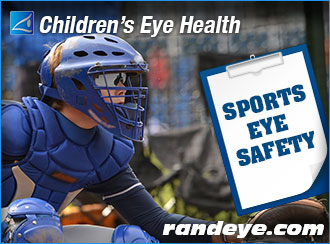
- Wear protective eyewear while participating in sports and recreational activities.
- Play with age-appropriate toys. Make sure your children avoid toys with sharp protruding parts or any flying or broken pieces that could end up in their eyes. If they’re carrying sharp objects, always point them to the ground.
- Wear approved goggles when swimming, even in pools. Chlorine helps reduce water-borne bacteria and viruses, but can also wash away the tear film that acts as a defensive shield for the cornea, leaving swimmers prone to eye infections.
Remember, your children learn from good examples. When you as parents also take precautions to protect YOUR eyes, you’ll SEE the impression it makes on your children.
Count on Rand Eye Institute to give you important facts and reminders about your child’s eye health and safety, especially when it comes to protecting their eyes this back to school season.
Fireworks Eye Safety on the 4th of July
We live in the land of the free, so we get to celebrate our love for America every year on the 4th of July. We barbecue, swim, play sports, get together with friends and family, and traditionally, we watch fireworks. Many of us take part in the setting off of fireworks. Know the law where you live concerning the use of personal fireworks, and know one other thing for sure: The law of averages could make you a statistic.
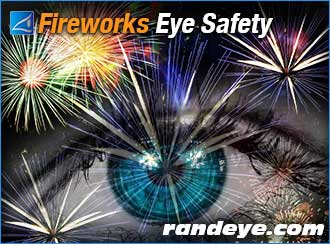
Thousands of people in the U.S. every year, many of them children, suffer eye injuries caused by fireworks. In the most severe cases, fireworks can rupture the globe of the eye, cause chemical and thermal burns, corneal abrasions and retinal detachment — all of which can permanently cause eye damage and affect vision.
In the year 2014, more than 10,500 fireworks-related injuries required treatment in an emergency room in the U.S., according to a recent fireworks injury report from the U.S. Consumer Product Safety Commission. Roughly 1 in 5 of those fireworks injuries was to the eyes and nearly half of those injured were bystanders, with children being frequent victims.
Here are Some Handy Fireworks Safety Tips
The best way to avoid a potentially blinding fireworks injury is by attending a professional public fireworks show rather than purchasing fireworks for personal use.
- Respect safety barriers and view fireworks from at least 500 feet away.
- Do not touch-unexploded fireworks; instead, immediately contact the local fire or police department to assist. You should never touch or pick up previously exploded fireworks debris.
- Remember, pets don’t enjoy fireworks like people do. Explosions are much louder and more frightening to dogs and cats, so it’s best to leave your pet with friends in a safe environment rather than bringing them to a fireworks display.
**PLEASE NOTE FOR EMERGENCY EYE CARE – OUR OPHTHALMOLOGISTS ARE ON-CALL 24/7
For those who decide to purchase consumer fireworks in states where they are legal, we recommend the following safety tips to prevent eye injuries:
- Never let young children play with fireworks of any type, even sparklers.
- People who handle fireworks should always wear protective eyewear that meets the parameters set by the American National Standards Institute and ensure that all bystanders are also wearing eye protection.
- The very best tip: Leave the lighting of professional-grade fireworks to trained pyrotechnicians.
What to do in the event of a fireworks eye injury:
- Seek medical attention immediately.
- Do not rub your eyes.
- Do not rinse your eyes.
- Do not apply pressure.
- Do not remove any objects that are stuck in the eye.
- Do not apply ointments or take any blood-thinning pain medications such as aspirin or ibuprofen.
Your doctor or eye professional is the most qualified, trained professional who can offer you the best assistance. Remember, safety is always first when it comes to your eyes. You have but ONE SET, so please take care of them.
**Should you experience a medical eye emergency, such as an injury or trauma to the eye or to the area surrounding the eye, infection, sudden eye pain or decreased vision, please call our office immediately at 954-782-1700. Our ophthalmologists are on-call 24/7 and will contact you as soon as possible.
In the event of severe trauma to the eye, or if you believe you have an extreme time sensitive eye emergency; call 911 or go to the nearest hospital emergency room while waiting for our doctor to return your call. This would avoid a delay in critical care in case for any reason our response is not immediate.
Hurricane Preparedness – Eye Safety Tips
Hurricane season is June 1st through November 30th. Forecasters at NOAA report that South Florida is in a “Hurricane Drought”, since our area has not endured a direct hit since Wilma crossed our state on October 24, 2005. Forecasters agree that now, more than ever, we should be alert and take the necessary precautions to prepare for an emergency, should we get a hurricane or other significant weather event.
Here are some hurricane tips for protecting your eyes:
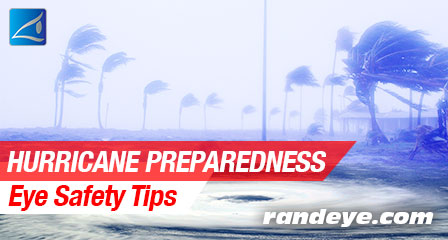
Safety First
- It may sound simple, but always wear eye protection when making hurricane preparations to your home. Even the smallest debris from drilling, or hammering nails into wood or concrete, could end up in your eyes. The easiest first step is to always wear goggles or protective eyewear.
- Make sure your tools are in good working condition, the hammer’s head is secure and that the nails and screws are not rusty or bent. Always wear a tool-belt when climbing ladders so that you can use your hands to safely steady yourself.
- If glass is breaking during a storm, put on protective eyewear and stay out of the path of flying glass or debris. Seek shelter in a protected area of your home.
- Read and follow label directions. Cleaning fluids, chemicals and gases could be dangerous, especially in combination with other substances. Wear gloves and protective eyewear at all times.
- Work with chemicals in a well-ventilated area and be sure that spray nozzles point away from you and others. Always wash your hands thoroughly afterward.
- Young children should not participate in dangerous storm preparation. If they are nearby, always provide protective eye wear or safety goggles for them. When working near debris or construction, wear sturdy shoes, not sandals or slippers.
- Avoid swimming in a pool or visiting a water attraction that may have become contaminated during a storm. Because of a power-outage or if there is storm debris in the pool, the water may be unsafe.
First Aid Eye Care
- Always have purified or bottled water on hand to rinse your eyes in the event that dust or other particles get into them. Do not rub your eyes, rinse them with purified water.
- Avoid using tap water in your eyes after a hurricane, since stagnant water may be contaminated. Again, have plenty of bottled water on hand.
- If debris hits the area around the eye, apply cold cloths for 15 minutes to reduce swelling. If swelling persists, see your doctor as soon as possible.
- If a sharp object like a twig or nail enters your eye, do not try to remove it yourself. Be careful not to apply pressure to the affected area. Go to a hospital or emergency room as soon as you safely can.
- Beware of chemicals splashing into your eyes, especially cleaning fluids, fuel or gasoline. If that happens, gently wash the eyes with purified water for at least 10 minutes. Go to a doctor or emergency room immediately. Never use a barbeque grill inside the home.
- Prepare Medicine and Supplies in Advance.
- Have a plentiful amount of your eye medications on hand as pharmacies may be closed during and after a storm. Store them in a clean, dry area for easy access.
- Keep eyeglasses and contact lens supplies where you can easily find them, including rewetting drops to refresh your eyes as needed.
There is often so much to do and much confusion during a hurricane, but always keep your eyes top of mind when preparing for a storm.
Eye Protection Tips – Wear Sunglasses
There are many easy ways to take care of your eyes; the most convenient is just throwing on a pair of your favorite sunglasses.
The Future’s so Bright You Gotta Wear Shades!
Sunglasses are a great fashion accessory, but they serve an even greater purpose than just making you look like a movie star! Their most important job is to protect your eyes from the sun’s ultraviolet (UV) rays. 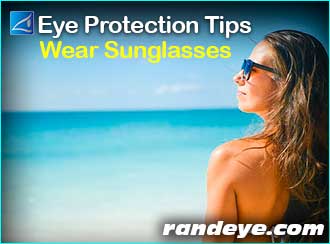
Here Comes The Sun!
Everyone knows that the sun’s rays are bad for our skin, but did you know that the sun can also do damage to your eyes? For example:
- Cataracts are a clouding of the eye’s lens that can blur vision. An estimated 20% of cases are caused by extended UV exposure.
- Macular degeneration, which results from damage to the retina that destroys central vision, is the leading cause of blindness in the United States.
- Pterygium, a tissue growth over the white part of the surface of the eye that can alter the curve of the eyeball, causes astigmatism.
So, Hats Off to Good Choices!
When choosing sunglasses, look for ones that block 99 to 100% of both UVA and UVB radiation, so you can keep your vision and your looks sharp and healthy. A hat offers great protection, too. So enjoy Healthy Vision Month by making smart vision choices.
Protect Your Eyes
An unprotected eye is an invitation for an injury to occur, especially while playing sports. But there are so many ways in which we can protect our eyes.
Here are some precautions that should be taken, when playing sports, to prevent eye injuries from happening.
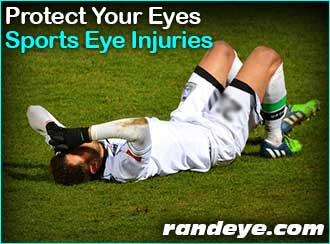
Baseball: Players should wear a faceguard made of a sturdy plastic or polycarbonate material along with eye goggles or eye guards.
Basketball: Players should wear eye goggles at all times in the event of an errant elbow, a stray poke from another player’s finger, or an errantly thrown basketball.
Soccer & football: Like other contact sports, an errant elbow, ball, foot, or finger can cause serious damage to the unprotected eye. Players should always wear sports eye guards and, in football, a full faceguard.
Hockey: Players should wear full polycarbonate material or a wire mask to prevent eye injuries and possible facial injuries.
Tennis or racquetball: To protect your eyes from a ball, or your opponent’s racquet, protective eye goggles should be worn at all times while playing this sport.
Most Common Sports Eye Injuries
The most common types of eye injuries that can result from sports injuries are blunt injuries, corneal abrasions and penetrating injuries
✦ Blunt injuries occur when the eye is suddenly compressed by the impact from an object. Blunt injuries, often caused by tennis balls, racquets, fists or elbows, can sometimes cause a black eye or hyphema (bleeding in front of the eye). More serious blunt injuries often break bones near the eye, and may sometimes seriously damage important eye structures and/or lead to vision loss.
✦ Corneal abrasions are painful scrapes on the outside of the eye, or the cornea. Most corneal abrasions eventually heal on their own, but a doctor can best assess the extent of the abrasion, and may prescribe medication to help control the pain. The most common cause of a sports-related corneal abrasion is being poked in the eye by a finger.
✦ Penetrating injuries are caused by a foreign object piercing the eye. Penetrating injuries are very serious, and often result in severe damage to the eye. These injuries often occur when eyeglasses break while they are being worn. Penetrating injuries must be treated quickly in order to preserve vision
Signs or Symptoms of an eye Injury:
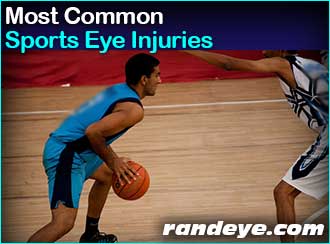
● Pain when looking up and down, or difficulty seeing ● Tenderness
● Sunken eye ● Double vision ● Severe eyelid and facial swelling ●Difficulty tracking ●The eye has an unusual pupil size or shape
● Blood in the clear part of the eye ● Numbness of the upper cheek and gum ● Severe redness around the white part of the eye
Sports Related Eye Injuries – Can Be Prevented
Ouch! It’s all fun and games until someone gets hurt!
Do You Know, that more than 25,000 people are treated for sports-related injuries each year, but there is good news: 90% of those injuries can be prevented!
Here are some tips to increase your injury Eye-Q:
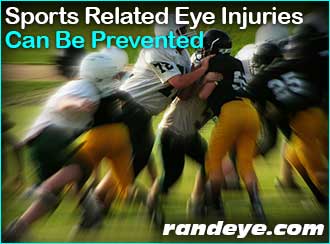
- Always wear proper safety goggles (lensed polycarbonate protectors) for racquet sports or basketball. In order insure that your eyes are protected, it’s important that any eye-guard or sports protective eyewear be labeled as ASTM F803 approved. This eyewear is performance tested to give you the highest levels of protection.
- Use batting helmets with polycarbonate face shields while playing baseball.
- Use helmets and face shields approved by the U.S. Amateur Hockey Association when playing hockey.
- Know that regular glasses don’t provide enough protection.
Know your Eye-Q, not just this month, but all year long, and take care of your eyes and your eye-health.
Simple Tips to Prevent Sports Eye Injuries
Its all fun and games until someone gets hurt!
More than 25,000 people are treated for sport-related injuries each year. But there is good news; 90% of these injuries can be prevented!
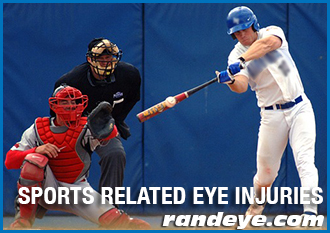
Here are some simple tips to prevent eye injuries:
- Wear proper safety goggles (lensed polycarbonate protectors) for racquet sports or basketball. In order to be assured that your eyes are protected, it is important that any eye guard or sports protective eyewear are labeled as ASTM F803 approved. This eyewear is performance tested to give you the highest levels of protection.
- Use batting helmets with polycarbonate face shields while playing baseball.
- Use helmets and face shields approved by the U.S. Amateur Hockey Association when playing hockey.
- When bike riding wear a helmet and safety glasses, with polycarbonate lenses and UV protection, to shield your eyes from damaging sunlight and debris.
- Know that regular glasses don’t provide enough protection.
Always wear the recommended safety equipment, for the sporting activity you will engage in.
Computer Vision Syndrome
As more of today’s workforce use computer monitors in the office, more often, workers are experiencing a new type of eye fatigue known as:
Computer Vision Syndrome
While there is no evidence that Computer Vision Syndrome causes any long-term damage to the eyes, regular computer use can be the source of significant eyestrain and discomfort.
If you have Computer Vision Syndrome, you may be experiencing some or all of these symptoms:

- Blurred vision
- Double vision
- Dry, red eyes
- Eye irritation
- Headaches
- Neck or back pain
Untreated, these symptoms can have a real effect on your work performance.
There is a way to relieve Computer Vision Syndrome just by making a few simple changes in your work environment.
Cut the glare
Changing the lighting surrounding your environment can reduce glare on your screen. Consider adding a movable shade to a nearby window. Lower the shade and move the monitor to the side slightly until the glare disappears. You might ask your employer to install a dimmer switch to the overhead lights, or add a desk lamp with a movable shade that distributes light evenly over your workspace. Adding a glare filter over your monitor screen can also help protect your eyes.
Rearrange your workspace
Research shows that the optimal position for your computer monitor is slightly below eye level, or about 20 to 28 inches away from the face. At this position, you should not have to stretch your neck or strain your eyes to see what’s on the screen. Use a copy stand to place any printed materials you may be working from on it so you don’t have to look up and down at the desk while you type.
Give your eyes a break
Look away from the screen every 20 minutes or so, gaze out the window or scan the room for about 20 seconds to rest your eyes to give them a chance to refocus and rest. Blink often to keep your eyes moist. If your eyes are dry, try using sterile lubricating eye drops.
Tweak your computer settings
Try adjusting the brightness, contrast and font size until you find the best settings for your vision. Most writing software programs have a percentage adjustment tab, commonly found at the very top center of your document that allows you to increase the font appearance temporarily and restore it when the document is complete.
Visit your eye doctor regularly for an exam, or schedule a comprehensive eye exam at The Rand Eye Institute. Let the doctor know about eyestrain or any other problems you might be experiencing at work. Call 800-782-1711
Eye Injury Serious Problem Prevention
As many precautions as we take, eye injury accidents do happen.
If you do injure your eye, it is important to know what to do in order to prevent any serious problems from happening.
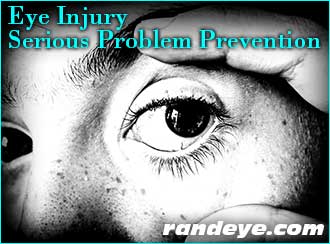
If you get something in your eye:
- Don’t rub the affected eye. Flush the eye with lots of water and see a doctor if the speck doesn’t wash out, or if pain or redness continues.
Cuts, Punctures, and Foreign Objects in the Eye
- Unlike specks of dust or metal, be sure not to wash out the affected eye. Do not try to remove a foreign object stuck in the eye. Seek immediate medical attention.
Chemical Burns
- Immediately wash the eye with water. Open the eye as wide as possible and continue flushing for at least 15 minutes, even on your way to seeking medical care.
Blows to the Eye
- Apply a cold compress without pressure, or tape crushed ice in a plastic bag to the forehead and allow it to rest gently on the injured eye. Seek immediate medical attention if pain continues, if you have reduced vision, or if blood or discoloration appears in the eye.
This list serves as simple eye safety tips, to prevent further eye problems, and in no way replaces professional emergency medical attention.
You must seek emergency medical care for any and all serious eye injuries.
